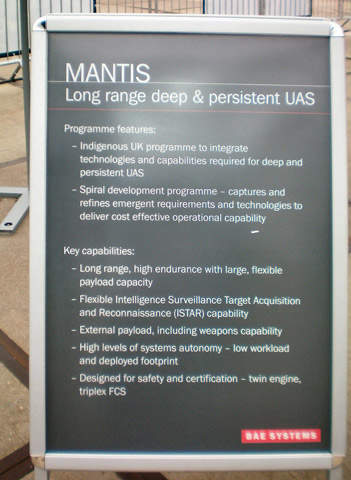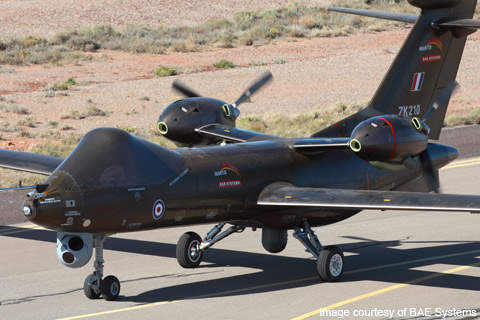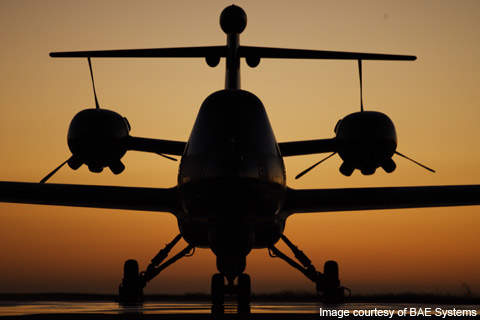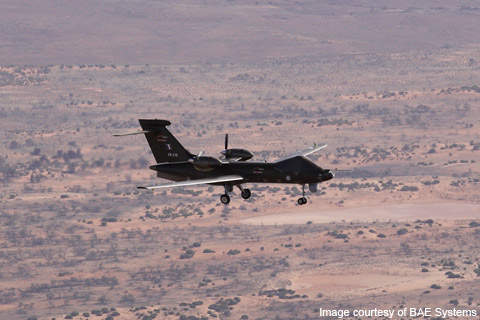The Mantis medium-altitude long-endurance unmanned air vehicle (UAV) system has been designed and developed by BAE Systems, UK, principally for UK Defence Forces to perform intelligence, surveillance, target acquisition and reconnaissance (ISTAR) operations. The UAV offers close-air support for ground missions and captures real-time intelligence data before transmitting it to the ground control station via satellite communication data link. The UAV will identify and destroy targets using its missiles or bombs.
The Mantis UAV is the first fly-by-wire all-electric-controlled UAV system to be developed by BAE Systems. The UAV completed its maiden flight on 21 October 2009 in Woomera, South Australia. Flying at a maximum altitude of 55,000ft (16,764m), the Mantis can provide its operators with real-time intelligence information by performing surveillance and target acquisition over a large area.
Mantis surveillance UAV design
Mantis has been designed to operate as a surveillance and military transport aircraft. It has been designed to be a machine with plug-and-play elements. The UAV is fitted with an upward-facing satellite communication system, situated in a large dome in the front side. The aircraft also features an electro-optic camera in the front section of the fuselage to capture imagery of the battlefield.
The UAV is designed to operate autonomously, even under adverse weather conditions. The automated functions of the UAV enable the ground station operators to focus on the overall task, rather than the vehicle control.
British demonstrator programme
Mantis was developed under the British Demonstrator programme. Development of the UAV began in 2007 and includes three phases. The first phase was jointly funded by BAE Systems and the UK Ministry of Defence (MoD).
Two Rolls-Royce Model 250 turboshaft engines were fitted to the UAV in phase I. The first phase development was carried out in Australia and involved the evaluation of autonomous control systems and ISTAR operations. The second phase was to focus on the sensor package developments and armaments. This would have been carried out in Afghanistan and tested weapons release activities. The third phase would have been to assess the civilian applications and armed variants of the UAV.
Mantis was showcased at Farnborough Air Show on 14 July 2008. It was also displayed at the Royal International Air Tattoo in July 2009 following the completion of its final assembly. After five flight trials and ground testing, the aircraft successfully completed phase I testing in November 2009.
The Mantis remained a concept and demonstrator after its Phase I trials after funding was removed in the 2010 Strategic Defence Review. However BAE Systems have continued to support the project and have planned to migrate technology from the Herti UAV program to the Mantis and revive flight testing in 2013. The Matis could also form the basis of the Telemos MALE deep and persistent ISTAR program.
Mantis features
Mantis has six hard points, three on each wing. These hard points are fitted with 12 MBDA Brimstone air-to-air missiles or six Raytheon pave-way precision guided bombs weighing 226kg each. It also features wescam, flight termination and communication systems, Atlantic inertial systems, primary flight control actuators, electrical braking systems and mission systems.
Navigation
The Mantis UAV can be controlled autonomously or manually from the ground control station. It is fully equipped with an automatic launch and recovery (ALR) system, which helps ensure automatic safe landing during communication failure with the GCS.
Sensors
The UAV is incorporated with electro-optical (EO) and infrared (IR) sensors, and electronic intelligence sensors (ELINT, COMINT). The EO sensor converts light rays into electronic signals for capturing images, real-time data and videos.
Radars
Mantis is fitted with SAR (synthetic aperture radar), SIGINT (signal intelligence) and COMINT (communication intelligence).
Engine
The UAV is powered by two Rolls-Royce RB250B-17 turboshaft engines. Each engine can produce 310kW of output power. The engines are manufactured by Rolls-Royce Industries, UK.
Performance
Mantis can fly at a maximum altitude of 55,000ft (16,764m). The maximum speed of the aircraft varies between 200kt (370km/h) and 300kt (555km/h). The maximum endurance of the UAV is 30 hours. The aircraft weighs around 1,000kg and its maximum take-off weight is 9,000kg.
Ground control station
Processing, retrieving and storing of the real-time data provided by the Mantis UAV are carried out at the ground control station (GCS). The GCS was manufactured by BAE Systems. Mantis and a fully operational GCS were displayed by BAE Systems at Aero India 2009.













